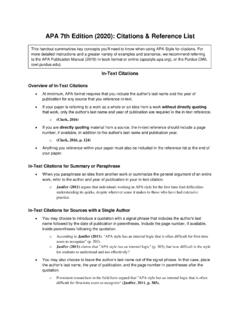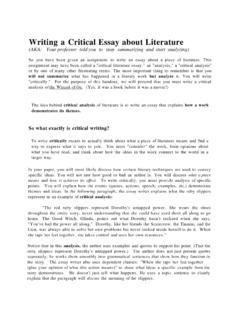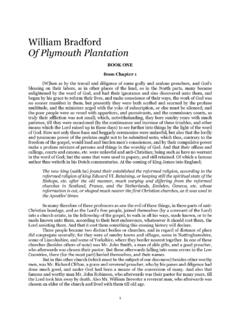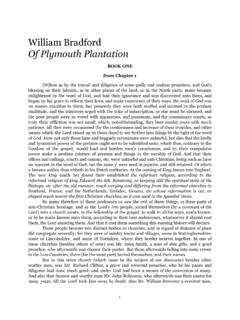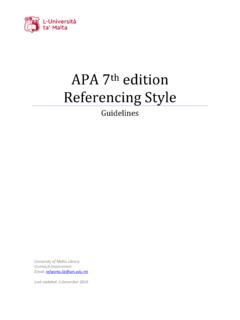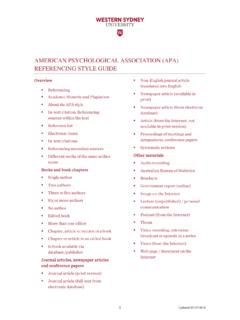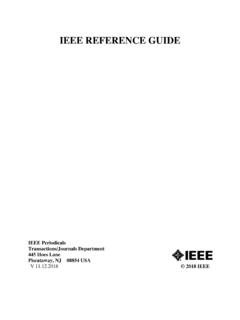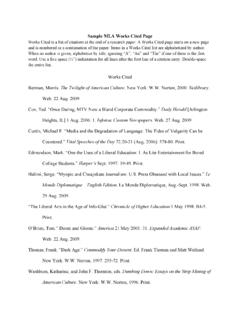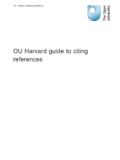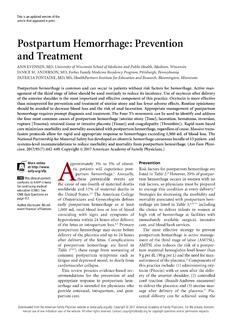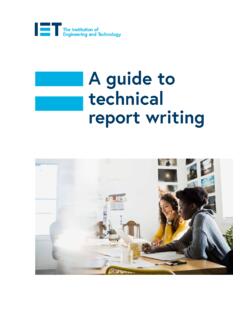Transcription of MLA 8th Edition (2016): Citations & Works Cited
1 MLA 8th Edition (2016): Citations & Works Cited Introduction General Guidelines MLA uses title case rules for titles of sources and the title of your paper. Capitalize all major words (nouns, pronouns, verbs, adjectives, adverbs). Titles of books and complete website names should be in italics. Titles of articles and individual webpages should be in "quotation marks." Dates are formatted with the day number followed by the month and the year. Ex: 10 Oct. 1981. All months except May, June, and July are abbreviated to 3 letters followed by a period. Many words may be abbreviated in your Works Cited list (but you should always spell them out in your paper): o p. for page, pp. for pages, par. for paragraph, qtd. for quoted, ed. for Edition , rev. for revised, vol. for volume, no. for number. Core Elements and Containers Each entry in the list of Works Cited is made up of core elements given in a specific order.
2 The core elements should be listed in the order in which they appear to the right. Each element is followed by the punctuation mark shown in the graphic. The MLA Style Center explains the elements or parts of a citation using the concept of containers. Sometimes a source stands alone, like a novel. Sometimes a source is part of a larger whole, like a short story in an anthology or an article in a newspaper; the larger whole can be thought of as a container. More examples and explanation are available at For more detailed instructions and a greater variety of examples and scenarios, we recommend referring to the MLA Handbook (2016), the MLA Style Center ( ), or the Purdue OWL ( ) MLA In-Text Citations Overview of In-Text Citations In MLA style, you must refer to material that is taken from the work of others by using parenthetical Citations .
3 To do this, place identifying information about your source in parentheses after a quote or a paraphrase. Parenthetical Citations must correspond to the source information listed on the Works Cited page. This means that the information you place inside your parenthetical Citations must reflect the listed author (or possibly title, if no author is listed) and page numbers (if available) of the corresponding entry in the Works Cited list. In-Text Citations for Sources with a Single Author MLA format stipulates that the author's last name and the page number(s) from which the quotation or paraphrase is taken must appear in your text. The author's name may be incorporated into the sentence itself or placed in parentheses following the quotation or paraphrase. The page number(s) must always be placed inside the parentheses.
4 For example: o Poe states that, for him, "poetry has not been a purpose, but a passion" (771). o Examining poems like "The Raven" and "Lenore" reveal a creative mind for which "poetry has not been a purpose, but a passion" (Poe 771). o Poe placed an emphasis on the powerful emotions driving the creation of his poetry (771). The parenthetical Citations in the above examples tell readers that the information in the sentence can be located on page 771 of a work by an author named Poe. If readers want more information about this source, they can turn to the Works Cited page, where they would find the following entry: o Poe, Edgar Allan. Complete Tales & Poems. Castle Books, 2002. In-Text Citations for a Work by Multiple Authors For a source with two authors, list the authors' last names in the text or in the parenthetical citation: o Maimon and Yancey argue that the majority of lessons about effective writing will come from outside college composition courses (14).
5 O The authors claim composition courses are helpful to incoming college students, but that an individual's "development as a writer only begins there" (Maimon and Yancey 14). For a source with three or more authors, use only the first author's last name, followed by the phrase "et al." (Latin for "and the rest"). o According to Tomik et al., "Current studies of college students reveal a 15% decrease in spelling proficiency between 2010-2020" (187). o The authors claim that current college students are markedly worse spellers than those students of a decade prior (Tomik et al. 187). In-Text Citations for Sources with No Known Author If you cannot find an author for a source, shorten the title and use that inside your parenthetical citation in the place of the author's last name. Titles of short Works (like articles) should be in quotation marks and titles of long Works (like novels) should be italicized.
6 If a page number is available, include it. o "How many there are in the world who run from others because they do not see themselves in them" (The Life of Lazarillo 7). This parenthetical citation would lead the reader to the Works Cited page, where the full title and other identifying information would appear in the complete entry. o The Life of Lazarillo de Tormes: His Fortunes and Adversities. Translated by Clements Markham, A&C Black, 1908. In-Text Citations for Sources with an Organization as Author If the author is an organization, use a shortened title of the text in the in-text citation, as you would for a source with no known author. The corresponding Works Cited list entry should also begin with the text title, not the name of the organization. o Dutchess Community College was founded in 1955, at a time when there were only 40 community colleges in the entire United States ("History of Dutchess").
7 O "History of Dutchess Community College: The Founding of a College." SUNY Dutchess, Accessed 15 Apr. 2020 In-Text Citations for Two or More Works by One Author When you cite more than one work by the same author, you should provide a shortened version of the source s title in your in-text citation to distinguish between the references. o (Kendi, Stamped 34) and (Kendi, How to Be 78) In-Text Citations for Two or More Works in the Same Parentheses When citing two or more sources that reference the same information, include the sources (by author name and page numbers) in alphabetical order, separated by a semi-colon. o (Abbas 21; Henley 104-07) In-Text Citations for Personal Communication Your personal communications ( , emails, interviews, letters) should be identified by the other person s last name.
8 If that person s name is mentioned within the sentence leading into the quote or paraphrased content, you do not need to repeat it in parentheses. The corresponding Works Cited entry should include your name and the date of the interview. o "It s safest to go with an experienced beekeeper for the first time you collect honey" (Smith). o Smith emphasized that you should accompany an experienced beekeeper if you ve never collected honey before. o Smith, Chima. E-mail interview. Conducted by Sara Abbadi, 31 Oct. 2018. In-Text Citations for Indirect Sources When you cite a source you found Cited in another source, it becomes an indirect source. Generally, you should try to find the original source, rather than citing an indirect source, but sometimes this proves difficult. In these cases, an indirect quotation can be used, but you must include qtd.
9 In as part of the parenthetical citation to indicate the source you actually consulted. o Gloom claims that colleges often strive to "serve as hubs of culture and learning for the communities they reside in" (qtd. in Doomsbury 18). In-Text Citations for Electronic Sources Because electronic sources do not generally possess page numbers, page numbers are not required in your in-text citation. Instead, you will signal your source by including in parentheses your author's name or the shortened title of the piece if the author's name is not available. o The Democrat & Chronicle reports that "the number of uninsured New Yorkers has fallen by million since NY State of Health started in 2013" (Spector). o The CDC recommends that "long-term care facilities should be vigilant to prevent the introduction and spread of COVID-19" ("People at Risk for Serious Illness").
10 MLA Works Cited Page: Guidelines and Format Guidelines for Different Numbers and Types of Authors For a work with one author, place the author s last name first, followed by their first name. o Doerr, Anthony. All the Light We Cannot See. Scribner, 2014. For a work with two authors, place the lead author s last name first, followed by their first name, then a comma and the second author s first name and last name. o Marks, Craig, and Rob Tannenbaum. I Want My MTV: The Uncensored Story of the Music Revolution. Garland. Dutton, 2011. For a work with three or more authors, list only the first author followed by the phrase et al. (Latin for and others ) in place of the remaining authors names: o Doll, Beth, et al. Resilient Classrooms: Creating Healthy Environments for Learning. Guilford, 2004. For a work by an organization, begin with the text title, not the name of the organization.
